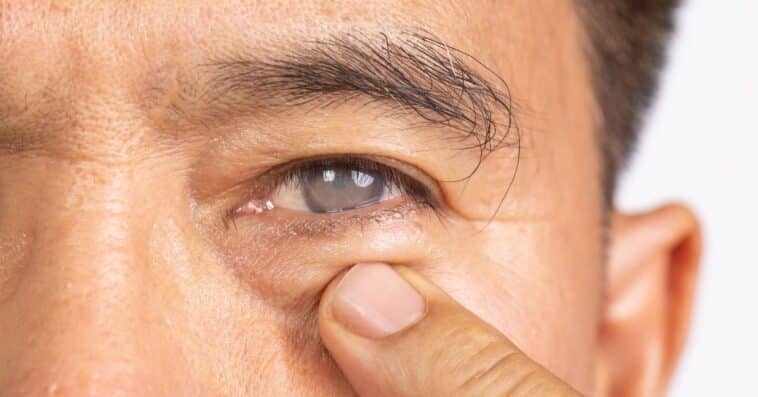What Is a Cataract?
A cataract is a cloudy area in the lens of your eye. When you have one, your vision can get blurry, hazy, or dim. Light doesn’t pass through as well, so things might look faded or unclear, almost like you’re looking through a foggy window.
Cataracts form when proteins in your lens break down and clump together. This makes it harder for your eye to focus light, so your vision slowly gets worse. The good news is that cataracts are common and can be treated.
- Blurred or cloudy vision that cannot be fully corrected with glasses
- Increased sensitivity to bright light and glare, especially from headlights or sunlight
- You might notice things look flat or washed out. It gets harder to tell objects apart from their backgrounds.
- Poor night vision is often one of the earliest complaints.
- Fading or yellowing of colors, particularly blues and purples
- Frequent changes in eyeglass prescription with limited improvement
If your cataracts get worse, it can be hard to do everyday things like reading, driving, or seeing people’s faces. Cataracts can cause serious vision loss if you don’t treat them, but they won’t damage your eye forever.
- The lens is exposed to oxidative stress over the course of decades.
- Lens proteins gradually lose their normal structure.
- The lens becomes less flexible, thicker, and more opaque.
- The eye’s ability to repair cellular damage decreases with age.
Getting older doesn’t mean you’ll definitely get cataracts, but it does make them more likely. Other things, like too much sun, smoking, diabetes, taking steroids, or family history, can make cataracts show up earlier.
Here are the main types, but cataracts can vary a bit for everyone.
- A- Age-Related Cataracts
This kind usually gets worse slowly. It can affect one or both eyes. Sometimes one eye is worse than the other.
- Congenital Cataracts
- Traumatic Cataracts
- Secondary Cataracts
- Diabetes
- Long-term corticosteroid use
- Previous eye surgery
- Chronic eye inflammation
- B-Cataracts Classified by Location in the Lens
- Gradual yellowing or browning of vision
- Reduced distance vision
- Temporary improvement in near vision (second sight)
- Glare and light sensitivity
- Difficulty with contrast
- Problems with night driving
- Severe glare from lights
- Difficulty reading
- Poor vision in bright conditions
Early Signs and Symptoms of Cataracts
Early cataract symptoms include blurry or cloudy vision, increased glare, difficulty seeing at night, faded colors, and a need for new glasses more often. These changes usually come on slowly and don’t hurt.
Early cataract symptoms are often subtle and painless, so many people don’t realize a cataract is starting. Vision changes usually happen slowly and can seem like normal aging or just tired eyes.
It’s important to catch these early signs. If you find cataracts early, your doctor can monitor them and plan treatment if needed.
Your vision might look a little hazy, foggy, or less sharp than before. Getting new glasses usually doesn’t fix this blur.
Increased glare and light sensitivity
Bright sunlight, headlights, or even indoor lights might feel uncomfortable or too bright. Glare is often one of the first and most noticeable symptoms.
Difficulty seeing at night
Many people with early cataracts have trouble driving at night because of glare, halos around lights, or trouble seeing well in the dark.
Colors may not look as bright, and whites can start to look yellow or dull. This change happens slowly, so you might not notice it at first.
Frequent changes in eyeglass prescription
If you need stronger glasses more often but they don’t really help, that’s a common early warning sign.
Double vision in one eye (monocular diplopia)
Some people see ghost images or double vision in one eye, and closing the other eye doesn’t make it go away.
- Trouble reading small print in normal lighting
- Needing brighter light for close work
- Reduced contrast between objects and backgrounds
- You might just feel like your vision is not quite right, even with glasses.
These symptoms can come and go at first, so you might think your vision problems are just temporary.
No. Cataracts do not cause eye pain, redness, or itching. If pain is present, another eye condition, such as glaucoma, inflammation, or dry eye, should be considered.
How Cataracts Are Diagnosed
Cataracts are diagnosed through a comprehensive eye examination. An eye doctor can often detect cataracts before vision is significantly affected, enabling proper monitoring and timely treatment.
Cataract Diagnosis: Patient-Friendly Explanation
How are cataracts diagnosed?
Cataracts are diagnosed through a comprehensive eye exam that includes visual acuity testing, refraction, slit lamp examination, and pupil dilation. These tests allow an eye doctor to detect cataracts and assess their impact on vision.
If you’re having blurry vision, glare, or trouble seeing at night, your eye doctor will start by asking about your symptoms and how they affect your daily life, like reading or driving.
- Whether a cataract is present
- How advanced it is
- Whether it is the main cause of your vision problems
Many people are surprised to find out they have early cataracts, even when their symptoms are mild.
- The cornea
- The anterior chamber
- The crystalline lens
- Lens clarity
- Retina and macula
- Optic nerve health
Dilation is essential to rule out other conditions that may cause similar symptoms, such as macular degeneration or diabetic retinopathy.
Some people have a lot of trouble seeing, even if their vision seems pretty good on the eye chart. In these cases, glare testing can help show vision loss caused by cataracts, especially posterior subcapsular cataracts.
When cataracts are moderate or advanced, your doctor might be able to see them during a basic exam. But early cataracts are usually invisible to the naked eye and need a special microscope to find them.
You might need cataract surgery when cataracts start to get in the way of your daily life and glasses, contacts, or better lighting don’t help enough.
- Driving, especially at night
- Reading or using digital screens
- Working or recognizing faces
- Managing glare from lights or sunlight
- Performing daily tasks safely and comfortably
If cataracts keep you from doing things safely or normally, surgery is usually the best choice.
- Vision remains blurry despite updated glasses.
- Increasing glare makes night driving unsafe.
- Colors appear dull or yellowed.
- Double vision persists in one eye.
- Frequent prescription changes provide little benefit.
- Vision interferes with work, hobbies, or independence.
These symptoms mean the cataract is causing real problems, even if it doesn’t look advanced to your doctor.
- Make surgery more technically difficult.
- Increase the risk of complications.
- Prolong unnecessary visual impairment.
Getting surgery earlier is often safer and helps you recover faster.
- Vision loss increases the risk of falls or accidents.
- Cataracts prevent proper monitoring of the retina or optic nerve.
- Other eye diseases (such as glaucoma and diabetic retinopathy) require clear visualization.
- Cataracts progress to very dense or advanced stages.
Cataract Surgery Explained
During cataract surgery, your doctor removes the cloudy lens in your eye with ultrasound and replaces it with a clear artificial one. The whole thing is painless, done as an outpatient, and usually takes less than 20 minutes.
Knowing what happens during surgery can help you feel less nervous and make good choices about your care.
- Confirm cataract severity
- Assess eye health (retina, cornea, optic nerve)
- Measure the eye for lens implant selection.
You and your doctor will talk about which lens is best for you, based on how you use your eyes every day and what you want to see clearly.
- You’ll go home the same day.
- Your doctor will use numbing eye drops, so you won’t need to be put to sleep.
- You’ll be awake, but you won’t feel any pain.
- The eye is cleaned and covered with a sterile drape.
The surgery doesn’t hurt.
- A tiny incision is made at the edge of the cornea.
- They use ultrasound to break up the cloudy lens into small pieces.
- Those pieces are gently suctioned out.
The cut is so small that it usually doesn’t need stitches.
- A clear artificial lens is put in your eye.
- The lens unfolds and is positioned securely.
- It stays in the eye permanently.
It helps you focus and see clearly again.
- Protective eye shield
- Prescription eye drops
- Post-operative instructions
Cataract surgery involves removing the cloudy natural lens using ultrasound and replacing it with a clear artificial lens. The procedure is painless, performed on an outpatient basis, and usually takes less than 20 minutes.
Cataract Surgery Recovery Timeline
Recovery is usually quick and easy, and most people see better soon after surgery.
- Vision may be blurry or hazy.
- Mild discomfort or a scratchy sensation is normal.
- An eye shield is worn, especially during sleep.
- Avoid rubbing the eye.
- Vision becomes clearer each day.
- Mild redness or light sensitivity may persist.
- Eye drops are used several times daily.
- Normal activities like walking and reading are allowed.
- You’ll probably notice things look much clearer and brighter.
- Glare usually decreases
- Light exercise is permitted.
- Avoid swimming, heavy lifting, or eye makeup.
- Vision stabilizes further
- Most restrictions are lifted.
- Prescription glasses (if needed) can be finalized.
- Full healing is complete.
- You’ll probably stop using eye drops around this time.
- Your long-term vision results are now set.
✔ Light sensitivity
✔ Foreign body sensation
- Severe pain
- Sudden vision loss
- Increasing redness or discharge
The best lens for you depends on what you want to see clearly. Monofocal lenses help you see far away, while multifocal and EDOF lenses can help you need glasses less often. Toric lenses are made to fix astigmatism.
How to Choose the Best IOL for You:
The best lens after cataract surgery depends on your vision needs. Monofocal lenses provide clear distance vision, while multifocal and EDOF (extended depth-of-focus) lenses can reduce reliance on glasses. Toric lenses are designed to correct astigmatism.
- Whether you want to reduce dependence on glasses
- Presence of astigmatism
- Retinal or corneal conditions
- Night driving sensitivity
- Budget and insurance coverage
There isn’t one lens that’s best for everyone. The right one is the one that fits your eyes and your life.
- Reduce dependence on glasses.
- Improve convenience and quality of life.
- Increase cost
- Causes glare or halos in some patients.
Cataract Surgery Risks & Complications
Problems from cataract surgery are rare. They can include infection, swelling, retinal detachment, or a cloudy lens capsule later on. Most of these can be treated, and the surgery works well for more than 98 out of 100 people.
Knowing about these risks can help you make good choices and not worry more than you need to.
- Mild eye discomfort or scratchy sensation
- Light sensitivity
- Temporary blurred vision
- Mild redness
- Watery eyes
- Very rare but serious
- Causes pain, redness, and vision loss
- Requires urgent treatment
- Swelling inside the eye
- Usually responds well to anti-inflammatory drops.
- Often temporary
- Monitored closely after surgery
- Sometimes called a “secondary cataract.”
- Causes blurry vision months or years later
- Easily treated with a quick, painless laser procedure (YAG capsulotomy)
- Rare, but more likely in high myopia or previous eye disease
- Symptoms include flashes, floaters, or curtain-like vision loss.
- Lens displacement or incorrect power (uncommon)
- It can usually be corrected
- Thorough pre-surgery evaluation
- Sterile surgical techniques
- Advanced imaging and measurements
- Post-operative follow-up
Cataract Surgery Cost
- Pre-operative exams
- Surgery procedure
- Monofocal intraocular lens (IOL)
- Post-operative care.
- Copays or deductibles
- Fees for upgraded technology
- Additional testing
| Lens Type | Extra Cost | Benefit |
| Multifocal | Higher | Reduces need for reading glasses |
| EDOF | Moderate–High | Better intermediate vision |
| Toric | Moderate | Corrects astigmatism |
- You want more freedom from glasses.
- You use screens or read frequently.
- You have astigmatism
- You frequently drive at night.
- You have certain retinal conditions.
- Budget is a concern
- Progress slowly or rapidly
- Causes serious vision problems.
- Increase the risk of falls and accidents.
- Prevent proper monitoring of other eye diseases.
- Combined with glaucoma or diabetes
- Vision loss affects safety.
- Retinal disease cannot be monitored.
- Cataracts become extremely advanced.






